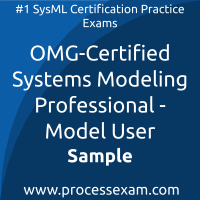 You have to pass the OMG-OCSMP-MU100 exam to receive the certification from OMG. To increase the effectiveness of your study and make you familiar with the actual exam pattern, we have prepared this OMG OCSMP sample questions. Our Sample OMG-Certified Systems Modeling Professional - Model User Practice Exam will give you more insight about both the type and the difficulty level of the questions on the OMG SysML MU exam.
You have to pass the OMG-OCSMP-MU100 exam to receive the certification from OMG. To increase the effectiveness of your study and make you familiar with the actual exam pattern, we have prepared this OMG OCSMP sample questions. Our Sample OMG-Certified Systems Modeling Professional - Model User Practice Exam will give you more insight about both the type and the difficulty level of the questions on the OMG SysML MU exam.
However, we are strongly recommending practice with our Premium OMG-Certified Systems Modeling Professional - Model User Practice Exam to achieve the best score in your actual OMG-OCSMP-MU100 Exam. The premium practice exam questions are more comprehensive, exam oriented, scenario-based and exact match of OMG-Certified Systems Modeling Professional - Model User exam questions.
OMG OCSMP Sample Questions:
01. What is the purpose of a state-transition model in requirements engineering?
a) To identify the actors involved in the system
b) To describe the flow of events and interactions between actors and the system
c) To capture the structure of the system's data
d) To specify the behavior of the system as it responds to stimuli
02. How are allocations normally managed on SysML tools?
a) With Machine state Diagrams
b) With Allocation Matrices
c) With N2 Diagrams
d) With Allocation Diagrams
03. Which model of requirements is most suitable for specifying business processes?
a) Activity models
b) Use case models
c) Object models
d) State-transition models
e) Data models
04. What is the difference between SysML and MBSE?
a) MBSE captures the modelling information as part of a SysML approach
b) SysML is the syntax of MBSE
c) They are the same thing
d) SysML captures the modelling information as part of an MBSE approach
05. What is the primary purpose of an Activity Diagram in system behavior modeling?
a) To depict the static structure of a system in terms of classes and their relationships
b) To illustrate the interactions between actors and the system
c) To specify the sequence of messages between system components
d) To describe the dynamic behavior of a system in terms of activities and their dependencies
06. What diagram would be most useful to communicate with the stakeholders?
a) Activity
b) Parametric
c) Use Case
d) Communicate what to whom?
07. According to the SE Handbook by INCOSE, what are valid "allocations"?
(Choose two)
a) Allocating activities to sequences
b) Allocating physical to logical structures
c) Allocating resources to structures
d) Allocating behaviors to structures
08. Which model of system behavior is used to represent the behavior of a system as a series of states and the transitions between them?
a) Activity model
b) State-transition model
c) Process model
d) Flow model
09. When does MBSE shows its value?
a) During the system lifecycle
b) When stakeholders request clarifications
c) When there is change
d) At the beginning of the system lifecycle
10. Which modeling technique is best suited for representing the hierarchical decomposition of a system into subsystems or modules?
a) Class Diagram
b) Package Diagram
c) Composite Structure Diagram
d) Sequence Diagram
Answers:
Question: 01
Answer: d |
Question: 02
Answer: b |
Question: 03
Answer: a |
Question: 04
Answer: d |
Question: 05
Answer: d |
Question: 06
Answer: c |
Question: 07
Answer: c, d |
Question: 08
Answer: b |
Question: 09
Answer: c |
Question: 10
Answer: b |
If you find any errors or typos in OMG-Certified Systems Modeling Professional - Model User (OMG-OCSMP-MU100) sample question-answers or online OMG SysML MU practice exam, please report them to us on feedback@processexam.com
 You have to pass the OMG-OCSMP-MU100 exam to receive the certification from OMG. To increase the effectiveness of your study and make you familiar with the actual exam pattern, we have prepared this OMG OCSMP sample questions. Our Sample OMG-Certified Systems Modeling Professional - Model User Practice Exam will give you more insight about both the type and the difficulty level of the questions on the OMG SysML MU exam.
You have to pass the OMG-OCSMP-MU100 exam to receive the certification from OMG. To increase the effectiveness of your study and make you familiar with the actual exam pattern, we have prepared this OMG OCSMP sample questions. Our Sample OMG-Certified Systems Modeling Professional - Model User Practice Exam will give you more insight about both the type and the difficulty level of the questions on the OMG SysML MU exam.